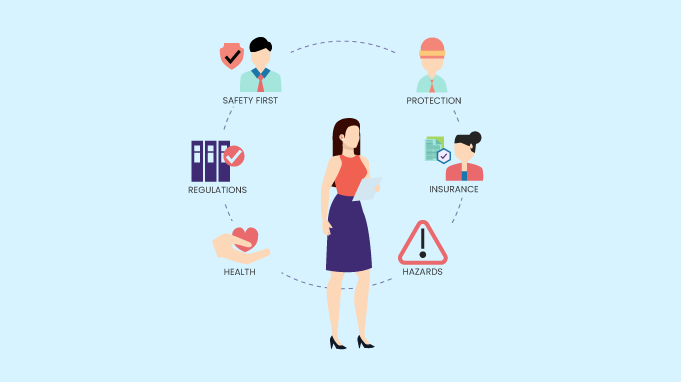The health and safety of employees are of supreme importance in any workplace or business. Every employer wants their workforce to be safe and healthy while at work. It is not only because it is the right thing to do but also mandated by law. Numerous occupational safety and health regulations require managers and supervisors to provide a safe and healthy work environment.
As an employer, you must guarantee that your organization complies with these guidelines and standards. One such standard is the IOSH Working Safely certification which provides staff members with the knowledge and skills they need to work safely and effectively.
This piece of content will look at what is needed for health and safety in the workplace, including the importance of maintaining a safe and secure working environment.
Legal Requirements for Workplace Health and Safety
The Occupational Safety and Health Administration or OSH has guidelines that outline the legal requirements for health and safety in the workplace. OSHA is responsible for setting and implementing safety standards at work. As an employer, you must ensure that your workplace is compliant with these procedures and processes.
OSHA guidelines cover a range of safety and health issues, including hazardous materials, workplace violence, and ergonomics. Employers must train employees to identify hazards, protect themselves from them, and fulfill these safety standards and guidelines.
It is also important to note that OSHA guidelines are not static. They are updated occasionally to reflect technological changes, working situations, and evolving workplace hazards. Employers are responsible for keeping up-to-date with these changes and making any required adjustments to their work environments to ensure compliance.
Common Workplace Hazards
Every business poses its unique threats. However, some common health risks are present in almost every company or organization. These hazards include slips, trips, falls, hazardous materials, and ergonomic hazards.
- Slips, Trips & Falls
Slips, trips, and falls injuries are among the common reasons for workplace accidents or ill health. To prevent these types of accidents, responsible persons must ensure that floors are clean and dry, walkways are clear and clutter-free, and workers wear slip-resistant footwear to work safely.
- Hazardous Substances
Hazardous materials are also a common workplace hazard. These substances can include chemicals, gases, and other harmful materials that can produce various risks to workers’ health.
Employers need to take accountability that employees working with hazardous materials are trained to handle them safely. They should also provide appropriate personal protective equipment (PPE) including gloves, goggles, and respirators.
- Ergonomic Hazards
Ergonomic hazards refer to the physical stresses caused by repetitive motion or awkward postures. These hazards can lead to musculoskeletal disorders such as carpal tunnel syndrome and lower back pain. To prevent ergonomic hazards, employers should ensure that workstations are correctly designed and that employees take frequent breaks to stretch and rest.
Preventing Workplace Injuries and Illnesses
Preventing workplace injuries and illnesses should also be a major priority for every employer. To do this, employers should provide safety training and education for employees. It must include information on how to recognize hazards and how to protect themselves from them. It should also include necessary information on how to use PPE correctly.
In addition to training, employers should also have safety protocols in place. These safety protocols should include emergency procedures, such as what to do during a fire or other emergency.
Employers must also have policies in place for reporting accidents, injuries, or near-miss incidents. It will allow them to identify and address potential hazards before they result in more severe incidents.
Promoting Workplace Health and Wellness
Promoting health and wellness in the workplace can significantly affect an employee’s overall health and productivity. Workplace wellness programs may include initiatives like healthy eating, exercise, and stress management programs.
Healthy eating programs can include initiatives such as providing healthy snacks and drinks in the workplace or offering healthy meal options in the company cafeteria.
Exercise programs may include offering gym memberships or setting up a walking or running club.
Stress management programs can include providing access to counseling services or offering relaxation techniques such as yoga or meditation to manage workplace stress. By promoting workplace health and wellness, employers can create a positive work environment.
Summary
In conclusion, ensuring workplace health and safety is crucial for employers and employees. Not only is it the right thing to do, but it is also mandated by law. Employers are responsible for providing a safe and healthy work environment for their employees at any cost. It includes complying with OSHA guidelines, identifying and addressing potential workplace hazards, and providing safety training and education to ensure a safe and secure work environment.
In addition to promoting safety, employers should also prioritize workplace health and wellness. Workplace wellness programs can have a significant impact on the overall health and productivity of employees.
Companies can create a positive work environment where employees feel valued and supported by prioritizing workplace health and safety. It results in increased employee satisfaction, productivity, and staff retention.
As an employer, you are responsible for ensuring that your workplace is safe and healthy for your employees. Doing so can help create a safer, healthier, and more productive workplace for everyone.

